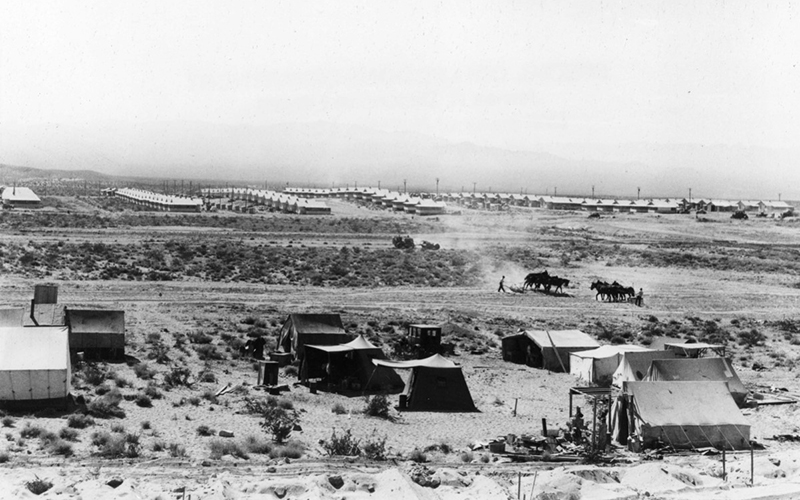
Edith Powell, the first female resident in the Boulder City townsite, and her dog, circa 1931. She moved there with her husband, who was working on Boulder Dam. (Photo courtesy of Nevada State Museum)
LAS VEGAS — What we now know as Hoover Dam was one of the most impressive and recognizable feats of engineering of the 20th century.
And in the 1930s, the construction of Boulder Dam and Boulder City helped put southern Nevada on the map.

Construction of Boulder Dam – renamed Hoover Dam in 1947 – lasted from 1931 to 1936. (Photo courtesy of Nevada State Museum)
But some of the people who helped build the dam and its related city are not as well-known: The women.
Dennis McBride, director of the Nevada State Museum in Las Vegas, is giving a presentation in August about – as he puts it – “Those Dam Women,” exploring the legacy of how women helped make possible one of the largest infrastructure projects in American history.
“The stories of the women that were involved in various roles has been overlooked,” he told Nevada Public Radio’s “State of Nevada.”
McBride said women may not have done actual construction work on the dam, but that is the only thing they didn’t do for the project and the town.
He said they created businesses, schools and sports organizations – everything a town with nothing in it would need.
“We can’t forget that one of the most important roles that women played were as wives and mothers,” he said, pointing out that “traditional” doesn’t mean insignificant or unimportant.
Most of these women came out to an empty southern Nevada and made homes out of tents, as well as shacks made of powder boxes and even the backs of cars, while their husbands worked on the dam, McBride said.
“That can’t be underestimated – the importance and the effort that that took,” he said.
Boulder City was supposed to be built before construction on the dam started, but the stock market crash and the Great Depression meant workers started pouring into the area before the town was complete.
McBride said workers pulled off the side of the road and set up tents, creating a community out of nothing.
The first female in the Boulder City townsite was Edith Powell, whose husband was working on the water tank at the top of the dam. The workers for that project set up tents before there was anything else there.
McBride said the people in charge of creating that community primarily were the women.
“The (phrase) that comes to mind is ‘It takes a village,'” he said. “It was the women that made Boulder City the village that was necessary to create lives and homes and futures for the people who chose to stay on there.”
Although many women came out with their husbands who were looking for work, others arrived to start businesses of their own.
“But there were many women who came out to be entrepreneurs and business people,” McBride said. “So there was a nice mix. It just depended on where you were when the Depression hit.”
If an unmarried woman who had to earn a living on her own came to Boulder City, McBride said she would find plenty of work to do.

About 1931, the site of what became Boulder City started to take shape, as tents, shacks and other temporary housing for workers building Boulder Dam were erected. (Photo courtesy of Nevada State Museum)
One of the women who came out to Boulder City while the dam was being built was Ida Browder, a widow from Salt Lake City who set up the first commercial business in the townsite: a lunch counter called Browder Lunch.
From there, Browder became a politically powerful woman – who eventually was dubbed the unofficial mayor of Boulder City.
Another political powerful woman from the time was Teddy Fenton, who essentially was a mail-order bride from North Dakota. She eventually ended up owning a lot of property and became extremely influential.
“People like (former Nevada Gov.) Mike O’Callaghan would come out, and they used to call it ‘to kiss Teddy’s ring’ to get her endorsement, because they knew if they got Teddy’s endorsement they had Boulder City,” McBride said.
There’s a park named after Fenton, which is now at risk of disappearing, McBride said. Other than that, he said, there is very little in the way of a memorial to the women who helped build the community and keep the Boulder Dam project moving forward.
This story is part of Elemental: Covering Sustainability, a new multimedia collaboration between Cronkite News, Arizona PBS, KJZZ, KPCC, Rocky Mountain PBS and PBS SoCal.
Connect with us on Facebook.